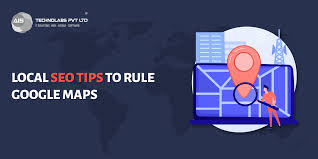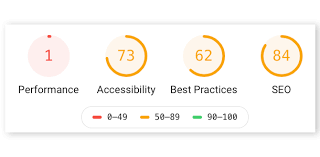Unlocking the Power of Google Maps SEO for Your Business
In today’s digital age, having a strong online presence is crucial for businesses of all sizes. One powerful tool that can significantly boost your visibility and attract local customers is Google Maps. With its widespread usage and popularity, optimizing your business for Google Maps SEO can be a game-changer.
Google Maps SEO refers to the process of optimizing your business listing on Google Maps to improve its visibility in local search results. By implementing effective strategies, you can increase your chances of appearing in the coveted “Local Pack” or “Map Pack,” which are the top three local listings that appear above organic search results.
So, how can you harness the power of Google Maps SEO to drive more traffic and customers to your business? Here are some key strategies to consider:
- Claim and Optimize Your Business Listing: Start by claiming your business on Google My Business (GMB) and providing accurate and up-to-date information about your company. Ensure that all details such as name, address, phone number (NAP), website URL, business hours, and categories are correct.
- Consistent NAP Across Online Directories: Maintaining consistent NAP information across various online directories is crucial for building trust with both users and search engines. Inconsistencies or inaccuracies can negatively impact your rankings. Regularly audit and update your NAP information on directories such as Yelp, Yellow Pages, and Facebook.
- Encourage Positive Reviews: Reviews play a vital role in local search rankings. Encourage satisfied customers to leave positive reviews on your GMB listing. Responding to reviews promptly shows engagement and helps build credibility with potential customers.
- Use Relevant Keywords: Incorporate relevant keywords into your GMB listing description, business name (if appropriate), categories, and attributes section. Conduct keyword research specific to your location and industry to identify high-impact keywords that will help improve your visibility in local searches.
- Optimize Your Website for Local SEO: Implementing on-page SEO strategies on your website can indirectly improve your Google Maps rankings. Ensure your website includes location-specific keywords, has a user-friendly interface, and provides valuable content that aligns with local search intent.
- Build Local Citations: Local citations are online mentions of your business’s NAP information on other websites, directories, and platforms. Building high-quality citations from reputable sources can boost your local search rankings. Focus on industry-specific directories, local chamber of commerce websites, and other relevant platforms.
- Leverage Google Posts: Google Posts allow you to share updates, promotions, events, and offers directly on your GMB listing. Utilize this feature to engage with potential customers and increase visibility within the Google Maps ecosystem.
- Embed a Google Map on Your Website: Embedding a Google Map on your website not only helps visitors find your physical location easily but also signals to search engines that you are a local business. This can positively impact your local search rankings.
- Monitor and Analyze Performance: Regularly monitor the performance of your Google Maps listing through tools like Google My Business Insights. Analyze data such as views, clicks, calls, and driving directions to gain insights into user behavior and make informed decisions about optimizing your listing further.
- Stay Active and Engage with Users: Actively engage with users who interact with your GMB listing by responding to questions, comments, or messages promptly. This demonstrates excellent customer service and increases the likelihood of conversions.
By implementing these strategies consistently over time, you can enhance your visibility in local searches and attract more customers to your business through Google Maps SEO. Remember that optimizing for local search is an ongoing process as algorithms evolve and consumer behavior changes. Stay informed about the latest trends in local SEO to ensure that you stay ahead of the competition and reap the benefits of increased online visibility and foot traffic.
9 Frequently Asked Questions About Google Maps SEO
- How can I optimize my website for Google Maps SEO?
- What are the best practices for optimizing a website for Google Maps SEO?
- What techniques should I use to improve my website’s visibility on Google Maps?
- How can I make sure my business appears in local search results on Google Maps?
- How do I add keywords and meta tags to optimize my website for local searches on Google Maps?
- What factors influence ranking in local searches on Google Maps?
- How can I track changes in rankings of my business listing on Google Maps?
- Are there any tools available to help me with optimizing my website for local searches on Google Maps?
- Is there a way to increase the number of reviews and ratings of my business listing on Google Maps?
How can I optimize my website for Google Maps SEO?
Optimizing your website for Google Maps SEO can help improve your visibility in local search results and drive more traffic to your business. Here are some key steps to follow:
- Include Relevant Keywords: Incorporate location-specific keywords throughout your website’s content, including in page titles, headings, meta descriptions, and within the body of your text. This helps search engines understand the geographical relevance of your website.
- Create a Contact Page: Make sure your website has a dedicated contact page that includes your business name, address, phone number (NAP), and email address. Use the same NAP information consistently across all pages of your website.
- Implement Schema Markup: Schema markup is structured data that provides search engines with additional information about your business, such as its name, address, phone number, opening hours, and customer reviews. Adding schema markup to your website’s code can enhance its visibility in local search results.
- Optimize Page URLs: Ensure that each page URL on your website includes relevant keywords and location information. For example, if you have multiple locations or serve specific areas, create separate landing pages for each location with unique URLs.
- Embed a Google Map: Embedding a Google Map on your website not only helps visitors find your physical location easily but also signals to search engines that you are a local business. You can embed a map on your contact page or any other relevant page.
- Optimize Images: When adding images to your website, optimize them by including alt tags that contain relevant keywords and location information. This helps search engines understand the context of the images and improves overall SEO.
- Mobile-Friendly Design: Ensure that your website is mobile-friendly and responsive since many users access Google Maps from their mobile devices. A responsive design ensures a seamless user experience across different screen sizes and improves rankings in mobile searches.
- Improve Website Speed: Website speed is an important ranking factor. Optimize your website’s loading time by compressing images, minifying CSS and JavaScript files, and utilizing caching techniques. This enhances user experience and positively impacts SEO.
- Build High-Quality Backlinks: Acquiring high-quality backlinks from reputable websites helps establish your website’s authority and credibility in the eyes of search engines. Focus on obtaining backlinks from local directories, industry-specific websites, and local business organizations.
- Monitor Analytics: Regularly monitor your website’s performance using tools like Google Analytics to gain insights into user behavior, traffic sources, and conversions. Analyze data specific to local traffic to identify opportunities for improvement.
Remember that optimizing your website for Google Maps SEO is an ongoing process. Stay updated with the latest best practices in local SEO and adapt your strategies accordingly. By consistently implementing these optimizations, you can increase your chances of ranking higher in local search results and attracting more customers to your business.
What are the best practices for optimizing a website for Google Maps SEO?
When it comes to optimizing your website for Google Maps SEO, there are several best practices you should keep in mind. By following these guidelines, you can increase your chances of appearing prominently in local search results and attracting more customers to your business. Here are some key strategies:
- Claim and Optimize Your Google My Business (GMB) Listing: Start by claiming your GMB listing and providing accurate and detailed information about your business. Ensure that all details such as name, address, phone number (NAP), website URL, business hours, and categories are correct and consistent across all platforms.
- Use Relevant Keywords: Incorporate location-specific keywords into your website’s content, meta tags, headings, and URLs. Conduct keyword research to identify high-impact keywords that potential customers might use when searching for businesses like yours in your area.
- Optimize Title Tags and Meta Descriptions: Craft compelling title tags and meta descriptions that include relevant keywords and accurately describe the content of each page on your website. This helps search engines understand the relevance of your pages to local searches.
- Create Location-Specific Landing Pages: If you have multiple locations or serve different areas, consider creating dedicated landing pages for each location. Optimize these pages with unique content tailored to each specific location to improve their visibility in local searches.
- Include NAP Information on Every Page: Make sure your business’s name, address, phone number (NAP), and other contact details are prominently displayed on every page of your website. This reinforces the relevance of your business to local searches.
- Embed a Google Map: Embedding a Google Map on your website not only helps visitors find your physical location easily but also signals to search engines that you are a local business. Be sure to embed the map with the same address as listed on your GMB profile.
- Implement Schema Markup: Utilize schema markup on relevant pages of your website to provide search engines with structured data about your business, such as your address, phone number, business hours, and reviews. This helps search engines understand and display this information more effectively.
- Optimize Website Speed: Ensure that your website loads quickly on both desktop and mobile devices. Site speed is an important factor for both user experience and search engine rankings.
- Build High-Quality Backlinks: Acquire high-quality backlinks from reputable websites in your industry or local community. These backlinks can help improve your website’s authority and visibility in local searches.
- Encourage Online Reviews: Positive online reviews not only build trust with potential customers but also impact your local search rankings. Encourage satisfied customers to leave reviews on platforms like Google Maps, Yelp, or industry-specific review sites.
- Mobile-Friendly Design: With the majority of searches now happening on mobile devices, it’s crucial to have a responsive and mobile-friendly website design. This ensures a seamless user experience across all devices.
- Monitor Performance and Analytics: Regularly monitor the performance of your website using tools like Google Analytics. Analyze data such as organic traffic, bounce rate, and conversions to gain insights into user behavior and make data-driven decisions for further optimization.
Remember that optimizing your website for Google Maps SEO is an ongoing process as algorithms evolve and consumer behavior changes. Stay up-to-date with the latest trends in local SEO to ensure that you stay ahead of the competition and maximize your online visibility in local searches.
What techniques should I use to improve my website’s visibility on Google Maps?
To improve your website’s visibility on Google Maps, there are several techniques you can employ. Here are some key strategies to consider:
- Claim and Optimize Your Google My Business (GMB) Listing: Start by claiming and verifying your business on Google My Business. Fill out all the required information accurately, including your business name, address, phone number (NAP), website URL, business hours, and categories. Make sure your listing is complete and up-to-date.
- Provide Accurate NAP Information: Consistency is crucial when it comes to your business’s name, address, and phone number (NAP) information. Ensure that the NAP details on your website match the information provided on your GMB listing and other online directories.
- Optimize Your GMB Description: Craft a compelling and keyword-rich description for your GMB listing that accurately represents your business. Incorporate relevant keywords naturally into the description while providing valuable information about your products or services.
- Encourage Customer Reviews: Positive reviews play a significant role in local search rankings. Encourage satisfied customers to leave reviews on your GMB listing by providing exceptional service or incentives for feedback. Responding promptly to reviews shows engagement and helps build trust with potential customers.
- Utilize Relevant Categories: Choose the most appropriate categories for your business in the GMB dashboard. Selecting relevant categories helps Google understand what services or products you offer, improving the chances of appearing in relevant searches.
- Add Photos and Videos: Visual content can enhance engagement with potential customers. Upload high-quality photos and videos that showcase your products, services, premises, or team members to make your listing more appealing.
- Embed a Google Map on Your Website: Embedding a Google Map displaying your location on your website can improve both user experience and search engine visibility. It signals to search engines that you have a physical presence in a specific area.
- Optimize Your Website for Local SEO: Implement on-page SEO techniques on your website to improve its visibility in local searches. Include location-specific keywords in your website’s content, meta tags, and headings. Ensure your website is mobile-friendly and loads quickly.
- Build Local Citations: Local citations are mentions of your business’s NAP information on other websites, directories, and platforms. Build high-quality citations from reputable sources to increase your website’s credibility and visibility in local searches.
- Leverage Online Directories: Submit your business information to relevant online directories such as Yelp, Yellow Pages, Bing Places, and industry-specific directories. Ensure that the NAP details are consistent across all directories.
- Monitor Performance and Make Adjustments: Regularly monitor the performance of your GMB listing through tools like Google My Business Insights. Analyze data such as views, clicks, calls, and driving directions to gain insights into user behavior. Use this data to make informed decisions about optimizing your listing further.
Remember that improving visibility on Google Maps is an ongoing process that requires consistent effort and monitoring. Stay up-to-date with best practices in local SEO and adapt your strategies accordingly to maintain a strong presence on Google Maps.
How can I make sure my business appears in local search results on Google Maps?
To ensure that your business appears in local search results on Google Maps, follow these essential steps:
- Claim and Optimize Your Google My Business (GMB) Listing: Start by claiming your business on Google My Business and providing accurate and detailed information about your company. This includes your business name, address, phone number (NAP), website URL, business hours, and categories. Make sure to fill out all available fields and provide high-quality images.
- Verify Your GMB Listing: Verifying your GMB listing is crucial to establish trust with Google and users. Google offers various verification methods such as mail, phone, email, or instant verification for eligible businesses. Follow the verification process promptly to gain access to all the features and benefits of a verified listing.
- Provide Accurate NAP Information: Consistency is key when it comes to your business’s Name, Address, and Phone Number (NAP) information. Ensure that your NAP details are accurate and consistent across all online directories such as Yelp, Yellow Pages, Facebook, industry-specific directories, and other relevant platforms.
- Select Relevant Categories: Choose the most appropriate categories for your business on your GMB listing. Selecting relevant categories helps Google understand what products or services you offer and improves the chances of appearing in relevant local search results.
- Encourage Positive Reviews: Reviews play a significant role in local search rankings. Encourage satisfied customers to leave positive reviews on your GMB listing by providing excellent service or products consistently. Responding to reviews promptly shows engagement with customers and boosts credibility.
- Optimize Your Website for Local SEO: Implement on-page SEO strategies on your website that align with local search intent. Include location-specific keywords in meta tags, headings, content, URLs, image alt tags, and schema markup where applicable.
- Build Local Citations: Local citations are mentions of your NAP information on other websites or directories. Build high-quality citations from reputable sources, such as industry-specific directories, local chamber of commerce websites, and relevant platforms. Ensure that your NAP information is consistent across all citations.
- Leverage Google Posts: Utilize Google Posts to share updates, promotions, events, and offers directly on your GMB listing. Regularly post engaging and relevant content to increase visibility within the Google Maps ecosystem.
- Encourage Engagement and Respond to Users: Actively engage with users who interact with your GMB listing by responding to questions, comments, or messages promptly. This demonstrates excellent customer service and increases the likelihood of conversions.
- Monitor Performance and Make Improvements: Use tools like Google My Business Insights to monitor the performance of your GMB listing. Analyze data such as views, clicks, calls, and driving directions to gain insights into user behavior. Adjust your strategies accordingly to optimize your listing further.
By implementing these steps consistently and staying up-to-date with local SEO best practices, you can improve the visibility of your business in local search results on Google Maps and attract more customers in your area.
How do I add keywords and meta tags to optimize my website for local searches on Google Maps?
Optimizing your website for local searches on Google Maps involves implementing relevant keywords and meta tags. Here’s a step-by-step guide on how to add them:
- Conduct Local Keyword Research: Start by conducting keyword research specific to your location and industry. Identify keywords that potential customers are likely to use when searching for businesses like yours in your area. Focus on long-tail keywords that include location-specific terms.
- Incorporate Keywords in Page Titles: Your page titles should be concise, descriptive, and include relevant keywords. Place location-specific keywords towards the beginning of the title tag to emphasize local relevance.
- Utilize Meta Descriptions: Meta descriptions provide brief summaries of your web pages in search engine results. Craft compelling meta descriptions that include relevant keywords and entice users to click through to your website.
- Optimize Heading Tags: Use heading tags (H1, H2, etc.) to structure your content and highlight important information. Incorporate location-specific keywords naturally within these headings where appropriate.
- Include Keywords in Page Content: Create high-quality, informative content that incorporates your targeted local keywords naturally throughout the text. Avoid keyword stuffing; instead, focus on providing value to readers while optimizing for search engines.
- Add Alt Text to Images: When adding images to your website, include descriptive alt text that includes relevant keywords and conveys the image’s context or purpose.
- Implement Schema Markup: Schema markup is structured data added to HTML code that helps search engines understand the content on your website better. Use schema markup specific to local businesses (e.g., LocalBusiness schema) to provide additional information about your business, such as address, phone number, operating hours, and customer reviews.
- Create Location-Specific Landing Pages: If you have multiple physical locations or serve different areas, consider creating dedicated landing pages for each location or area you target. Optimize these pages with location-specific keywords and content to increase their visibility in local searches.
- Optimize URL Structure: Incorporate relevant keywords and location information into your website’s URL structure. This helps search engines and users understand the context of your web pages.
- Monitor and Adjust: Regularly monitor the performance of your website using analytics tools. Analyze keyword rankings, organic traffic, and user behavior to identify opportunities for improvement. Adjust your keyword strategy and on-page optimization as needed.
Remember, optimizing your website for local searches is an ongoing process. Stay up-to-date with SEO best practices and algorithm updates to ensure that you continue to rank well in local search results on Google Maps.
What factors influence ranking in local searches on Google Maps?
Several factors influence the ranking of businesses in local searches on Google Maps. While the exact algorithm remains a closely guarded secret, here are some key factors that are known to have an impact:
- Relevance: Google considers how well a business listing matches the user’s search query. This includes factors such as the business category, keywords used in the listing, and the relevance of the content on the website.
- Proximity: The proximity of a business to the user’s location plays a significant role in determining its ranking. Google aims to provide users with results that are geographically relevant, so businesses closer to a user’s location have higher chances of appearing in local search results.
- Prominence: Prominence refers to how well-known and popular a business is both online and offline. Factors that contribute to prominence include online reviews, ratings, backlinks, social media presence, mentions on other websites, and offline reputation.
- Reviews and Ratings: Online reviews and ratings play a crucial role in local search rankings. Businesses with positive reviews and high ratings are more likely to appear prominently in local search results. Encouraging satisfied customers to leave reviews can significantly impact your ranking.
- NAP Consistency: Consistency of Name, Address, and Phone number (NAP) information across various online directories is important for building trust with both users and search engines. Inconsistent or inaccurate NAP information can negatively affect your rankings.
- Website Optimization: While Google Maps SEO primarily focuses on optimizing your business listing, having an optimized website can indirectly impact your ranking. Factors such as mobile-friendliness, page load speed, relevant content, and overall user experience contribute to better rankings.
- Citations: Citations refer to mentions of your business’s NAP information on other websites or directories. Building high-quality citations from reputable sources can boost your local search rankings.
- User Engagement: User engagement signals, such as clicks, calls, website visits, and requests for directions, can influence your ranking. Encouraging users to interact with your business listing and responding promptly to their inquiries can positively impact your visibility.
- Google My Business (GMB) Profile Completeness: Ensuring that your GMB profile is complete and accurate is vital. Provide detailed information about your business, including categories, services offered, business hours, website URL, and photos.
- Business Signals: Other factors such as the age of the business, domain authority of the website, the number of years in operation, and the consistency of information across various online platforms can also influence local search rankings.
It’s important to note that these factors work together in a complex algorithm that determines local search rankings on Google Maps. While you may not have control over all of them, focusing on optimizing your listing and providing a positive user experience can greatly improve your chances of ranking higher in local searches.
How can I track changes in rankings of my business listing on Google Maps?
Tracking changes in the rankings of your business listing on Google Maps is essential to understand the effectiveness of your optimization efforts and make informed decisions. Here are a few methods you can use to track these changes:
- Google My Business Insights: Google My Business (GMB) provides valuable insights about your listing’s performance. Log in to your GMB account and navigate to the Insights section. Here, you can find data on how customers found your listing (direct searches, discovery searches), the actions they took (website visits, phone calls), and where they came from (search or maps). Monitor these metrics regularly to track changes over time.
- Manual Search: Perform manual searches on Google Maps using relevant keywords and location-specific queries related to your business. Take note of where your listing appears in the search results and any changes in its position over time. Keep in mind that search results can vary based on factors like user location and search history.
- Third-Party Local SEO Tools: There are various third-party tools available that specialize in tracking local search rankings, including Google Maps rankings. These tools provide comprehensive reports on keyword rankings, visibility, and other metrics specific to local search results. Some popular options include Moz Local, BrightLocal, and SEMrush.
- Rank Tracking Software: Utilize rank tracking software specifically designed for monitoring keyword rankings across different search engines, including Google Maps. These tools allow you to input specific keywords and locations related to your business, track their positions over time, and generate detailed reports.
- Set Up Alerts: Consider setting up alerts or notifications using tools like Google Alerts or other online monitoring services. By creating alerts for specific keywords related to your business or industry, you can receive notifications whenever there are significant changes in the search results.
Remember that tracking rankings is not an exact science due to various factors influencing search results such as user preferences, location settings, and algorithm updates. It’s important to focus on long-term trends rather than day-to-day fluctuations. By consistently monitoring and analyzing your rankings, you can gain valuable insights and make data-driven decisions to improve your Google Maps SEO strategy.
Are there any tools available to help me with optimizing my website for local searches on Google Maps?
Yes, there are several tools available to help you optimize your website for local searches on Google Maps. Here are a few popular ones:
- Google My Business: While not a traditional tool, Google My Business (GMB) is an essential platform for managing your business listing on Google Maps. It provides insights, allows you to update information, respond to reviews, and post updates directly on your listing.
- Moz Local: Moz Local helps you manage your online presence across various directories and platforms. It ensures consistent NAP information and monitors your listings for accuracy and performance.
- BrightLocal: BrightLocal offers a suite of tools specifically designed for local SEO, including local citation building, rank tracking, review monitoring, and generating location-specific reports.
- Whitespark: Whitespark provides tools for local citation building and management. It helps you discover relevant directories for your industry and location and tracks the progress of your citations.
- Yext: Yext is a comprehensive platform that helps businesses manage their online listings across multiple directories and platforms. It ensures consistent NAP information, monitors reviews, provides analytics, and offers other features to improve local search visibility.
- SEMrush: While primarily known as an SEO tool, SEMrush also offers features specific to local SEO. It helps with keyword research, competitive analysis, tracking rankings in local searches, and identifying opportunities for optimization.
These tools can assist you in managing your online presence effectively, optimizing your website for local searches on Google Maps, monitoring performance metrics, and staying ahead of the competition in the ever-evolving world of local SEO.
Is there a way to increase the number of reviews and ratings of my business listing on Google Maps?
Absolutely! Increasing the number of reviews and ratings for your business listing on Google Maps can have a significant impact on your online reputation and local search rankings. Here are some effective strategies to encourage more reviews and ratings:
- Provide Excellent Customer Service: Deliver exceptional customer experiences to increase the likelihood of positive reviews. Focus on exceeding customer expectations, resolving issues promptly, and going the extra mile to make customers feel valued.
- Ask for Reviews: Don’t be afraid to ask satisfied customers to leave a review. You can do this in person, through email follow-ups, or by including a polite request on your website or receipts. Make it easy for customers by providing direct links or instructions on how to leave a review.
- Respond to Existing Reviews: Show that you value customer feedback by responding promptly and professionally to both positive and negative reviews. Acknowledge positive comments with gratitude and address negative feedback constructively. This demonstrates your commitment to excellent customer service.
- Offer Incentives: Consider offering incentives like discounts, freebies, or exclusive promotions for customers who leave a review. However, be cautious not to violate Google’s guidelines by offering incentives solely in exchange for positive reviews.
- Create Review Handouts or Cards: Design simple handouts or cards with instructions on how to leave a review and include them in packaging, shopping bags, or with receipts. This serves as a gentle reminder for customers to share their experience.
- Leverage Social Media Platforms: Promote your Google Maps listing on social media platforms like Facebook, Twitter, Instagram, LinkedIn, etc., and encourage followers to leave reviews directly on Google Maps.
- Utilize Email Marketing: Incorporate requests for reviews into your email marketing campaigns strategically. Send personalized emails asking satisfied customers if they would be willing to share their experience through a review.
- Train Your Staff: Ensure that your staff is aware of the importance of online reviews and trained in providing exceptional customer experiences. Encourage them to ask for reviews during interactions with customers.
- Display Review Badges or Widgets: Showcase positive reviews on your website by embedding Google review badges or widgets. This not only highlights your reputation but also encourages visitors to leave their own reviews.
- Engage with Local Influencers: Collaborate with local influencers or bloggers who have a significant following in your area. Offer them a complimentary experience or product in exchange for an honest review on Google Maps.
Remember, it is essential to follow Google’s guidelines and avoid any fraudulent activities, such as purchasing fake reviews or posting reviews yourself. Authenticity and transparency are key to building trust with both users and search engines.
By implementing these strategies consistently and providing exceptional customer experiences, you can encourage more customers to leave reviews and ratings on your Google Maps listing, ultimately boosting your online reputation and local search visibility.






